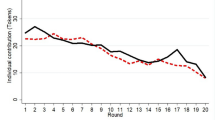Abstract
We reconsider evidence from experiments that claim to show that using “house money” in standard public goods experiments has no effect on behavior. We show that it does have an effect when one examines the data using appropriate statistical methods that consider individual-level responses and account for the error structure of the panel data.
Similar content being viewed by others
References
Ballinger, T. P., & Wilcox, N. T. (1997). Decisions, error and heterogeneity. Economic Journal, 107, 1090–1105.
Botelho, A., Harrison, G. W., Pinto, L. M. C., & Rutström, E. E. (2005). Testing static game theory with dynamic experiments: A case study of public goods. Working Paper 05–25, Department of Economics, College of Business Administration, University of Central Florida.
Camerer, C. (2003). Behavioral Game Theory. Princeton, NJ: Princeton University Press.
Cherry, T. L., Kroll, S., & Shogren, J. F. (2005). The impact of endowment heterogeneity and origin on public good contributions: Evidence from the lab. Journal of Economic Behavior & Organization, 57, 357–365.
Clark, J. (2002). House money effects in public good experiments. Experimental Economics, 5(3), 223–231.
Davis, D. D., & Holt, C. A. (1993) Experimental Economics. Princeton, NJ: Princeton University Press.
Hardin, J., & Hilbe, J. (2001). Generalized Linear Models and Extensions. College Station, TX: Stata Corporation.
Hardin, J., & Hilbe, J. (2003) Generalized Estimating Equations. Boca Raton: Chapman & Hall/CRC.
Hey, J. D. (2005). Why we should not be silent about noise. Experimental Economics, 8(4), 325–345.
Liang, K-Y., & Zeger, S. L. (1986). Longitudinal data analysis using generalized linear models. Biometrika, 73, 13–22.
Nelder, J. A., & Wedderburn, R. W. M. (1972). Generalized linear models. Journal of the Royal Statistical Society – Series A, 135(3), 370–384.
Pagan, A., and Ullah, A. (1999). Nonparametric Econometrics. New York: Cambridge University Press.
Smith, V. L. (1982). Microeconomic systems as an experimental science. American Economic Review, 72(5), 923–955.
StataCorp (2003a). Stata Statistical Software: Release 8.0. College Station, TX: Stata Corporation.
StataCorp (2003b). Stata Cross-Sectional Time-Series Reference Manual: Release 8.0. College Station, TX: Stata Corporation.
Wilcox, N. T. (2006). Theories of learning in games and heterogeneity bias. Econometrica, 74(5), 1271–1292.
Wooldridge, J. M. (2002). Econometric Analysis of Cross Section and Panel Data. Cambridge, MA: MIT Press.
Author information
Authors and Affiliations
Corresponding author
Additional information
JEL Classification D7 · C92
I am grateful for comments from two referees and an editor. All data and statistical code are available for public access at the ExLab Digital Library located at http://exlab.bus.ucf.edu.
Rights and permissions
About this article
Cite this article
Harrison, G.W. House money effects in public good experiments: Comment. Exp Econ 10, 429–437 (2007). https://doi.org/10.1007/s10683-006-9145-x
Received:
Revised:
Accepted:
Published:
Issue Date:
DOI: https://doi.org/10.1007/s10683-006-9145-x




